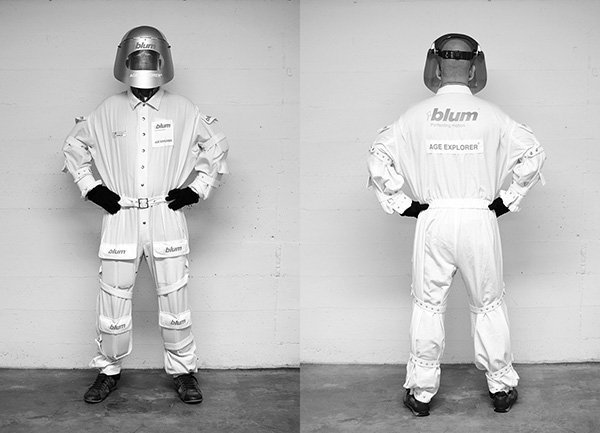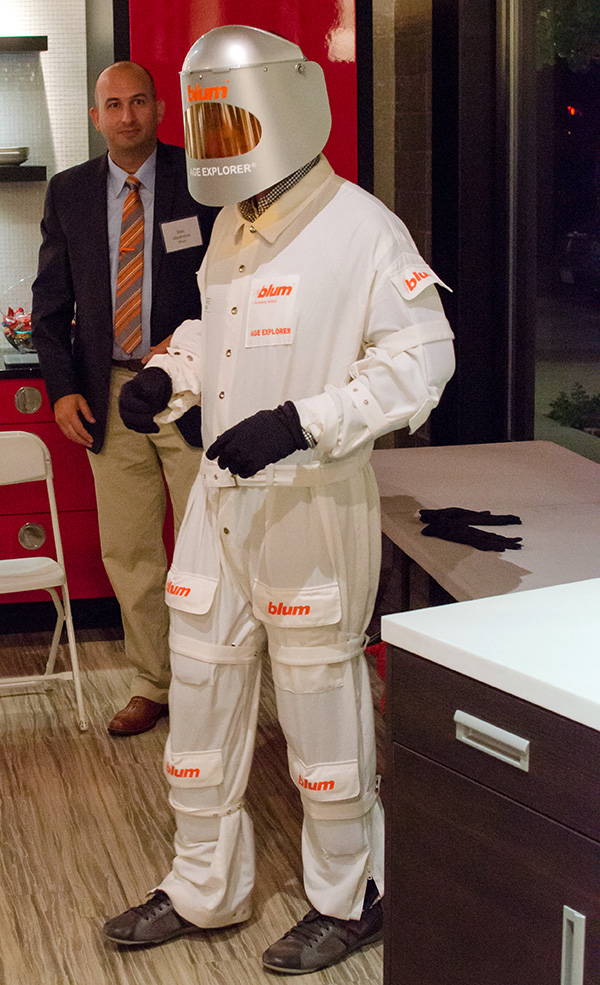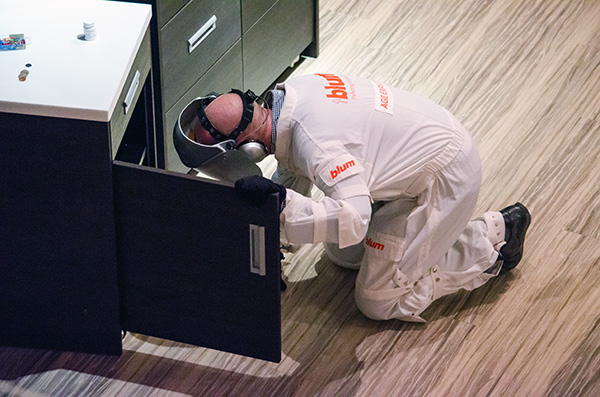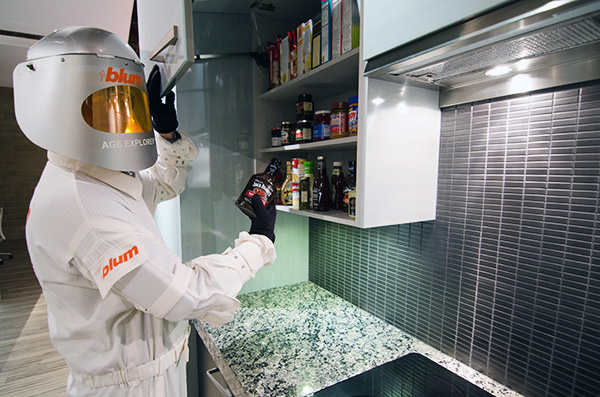EVERY KITCHEN TELLS A STORY, BUT IS IT ONE OF TODAY OR TOMORROW? IN CONJUNCTION WITH KITCHENS AT THE DENVER, HARDWARE INNOVATORS BLUM HAVE BROUGHT TO COLORADO A TOOL TO SIMULATE WHAT IT’S LIKE TO NAVIGATE THE KITCHEN AT 70 YEARS OLD—AND HAVE WORKED TOGETHER TO DEVELOP ERGONOMIC SOLUTIONS BOTH FUNCTIONAL AND FORWARD-THINKING. HERE’S HOW THEY DID IT BY USING RESEARCH, RETOOLING—AND TIME TRAVEL.
WORDS: CORY PHARE | IMAGES: ATOM STEVENS
 The man asks me for 67 cents. I fumble through the wallet’s coin purse, and two quarters clang to the concrete floor. I feel the eyes behind me tighten, and someone laughs. It doesn’t feel good.
The man asks me for 67 cents. I fumble through the wallet’s coin purse, and two quarters clang to the concrete floor. I feel the eyes behind me tighten, and someone laughs. It doesn’t feel good.
The idea posited by Blum—a maker of hinges, drawers, and lift systems—is how modern kitchen design should evolve with us as we age. I’m experiencing this firsthand, standing in the Kitchens at the Denver showroom, wearing the Age Explorer suit—a simulation designed to mimic the restrictive elements of aging 20 years or more. The special gloves reproduce decreased finger sensation and the onset of rheumatoid arthritis, which makes digging for change nearly impossible. Other tasks I’m asked to perform include selecting a blue spatula or green mixing bowl—impeded by vision-bending glasses—and retrieving items from the back of a pantry shelf, which becomes restricted by the elbow and knee bindings. All the while, I look part astronaut, part beekeeper, and part turn-of-the-century deep sea explorer.
 Initially developed by the Switzerland-based Meyer-Hentschel Institute, the Age Explorer suit contributes to Blum’s concept of Dynamic Space, or the integration of space, motion, and workflow. Extensive study into these elements led to better development and promotion of products such as Servo-Drive and Tip-On, the opening support for drawers, doors, and lift systems. “The thoughts behind using the Age Explorer and the research behind Dynamic Space go hand-in-hand,” said Blum’s Debbie Cannon. “Blum wants to develop products that span generational gaps, that are usable by everyone, and that suit everyone’s changing needs in the kitchen. We want them to be impressed with their designer’s ability to plan a kitchen that will continuously fulfill their needs as the years go by.”
Initially developed by the Switzerland-based Meyer-Hentschel Institute, the Age Explorer suit contributes to Blum’s concept of Dynamic Space, or the integration of space, motion, and workflow. Extensive study into these elements led to better development and promotion of products such as Servo-Drive and Tip-On, the opening support for drawers, doors, and lift systems. “The thoughts behind using the Age Explorer and the research behind Dynamic Space go hand-in-hand,” said Blum’s Debbie Cannon. “Blum wants to develop products that span generational gaps, that are usable by everyone, and that suit everyone’s changing needs in the kitchen. We want them to be impressed with their designer’s ability to plan a kitchen that will continuously fulfill their needs as the years go by.”
 Back in the showroom, I struggle to retrieve a stack of plates in a bottom drawer of a non-Blum outfitted unit. I need to get down on one knee, and it’s nearly impossible to get back up. Even without the suit, this layout isn’t conducive to natural movement—and that’s why everyone benefits from increased ergonomics and functionality, according to Gary Douglas, CKD, at Kitchens at the Denver. “It doesn’t have as much to do with being elderly as it does with being efficient with the space they have. Good designers automatically design for the future; the kitchen is a large investment that will last for decades, so the kitchen needs to be as functional today as it will be in 20 years.”
Back in the showroom, I struggle to retrieve a stack of plates in a bottom drawer of a non-Blum outfitted unit. I need to get down on one knee, and it’s nearly impossible to get back up. Even without the suit, this layout isn’t conducive to natural movement—and that’s why everyone benefits from increased ergonomics and functionality, according to Gary Douglas, CKD, at Kitchens at the Denver. “It doesn’t have as much to do with being elderly as it does with being efficient with the space they have. Good designers automatically design for the future; the kitchen is a large investment that will last for decades, so the kitchen needs to be as functional today as it will be in 20 years.”
 The key element to this livability is understanding one’s own personal needs and applying design principles to meet them today and tomorrow. The forced empathy of the Age Explorer suit enables this by contributing to the processes found in both Blum’s hardware and layouts at Kitchens at the Denver. The result: smart design, radical in functionality, built around use. “Planning a kitchen is a lot more than choosing what colors, materials, appliances, door styles, etc. are desired,” said Cannon. “It’s about creating an environment that will be comfortable to use and make things a bit easier for years to come, no matter what life brings.” That’s the sentiment I’m left with as I take the Age Explorer helmet off and am transported back to the present and future of kitchen design. The 67 cents now seems like a small price to pay for the experience.
The key element to this livability is understanding one’s own personal needs and applying design principles to meet them today and tomorrow. The forced empathy of the Age Explorer suit enables this by contributing to the processes found in both Blum’s hardware and layouts at Kitchens at the Denver. The result: smart design, radical in functionality, built around use. “Planning a kitchen is a lot more than choosing what colors, materials, appliances, door styles, etc. are desired,” said Cannon. “It’s about creating an environment that will be comfortable to use and make things a bit easier for years to come, no matter what life brings.” That’s the sentiment I’m left with as I take the Age Explorer helmet off and am transported back to the present and future of kitchen design. The 67 cents now seems like a small price to pay for the experience.




